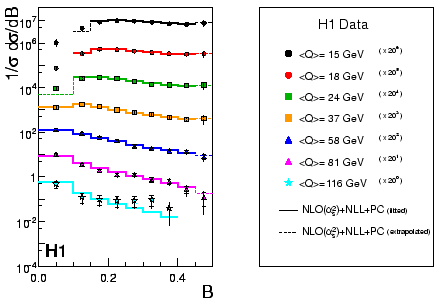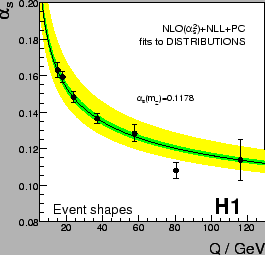The event topology or energy flow of the particles emitted in the current
hemisphere is conveniently described by a variety of event shape variables,
characterising the longitudinal and transverse momentum componenents
(thrust and jet broadening), the jet invariant mass or hadron-hadron
correlations (![]() parameter).
These infrared safe observables are in principle calculable
as subsequent emissions of quarks and gluons.
They represent an interesting interplay between the perturbatively calculable
hard sub-process and the non-perturbative hadronisation effects.
Perturbative calculations of event shape distributions have become available
in next to leading order (NLO) in the strong coupling
parameter).
These infrared safe observables are in principle calculable
as subsequent emissions of quarks and gluons.
They represent an interesting interplay between the perturbatively calculable
hard sub-process and the non-perturbative hadronisation effects.
Perturbative calculations of event shape distributions have become available
in next to leading order (NLO) in the strong coupling ![]() including
resummed contributions to account for higher orders.
Hadronisation corrections are traditionally applied by using phenomenological
Monte Carlo models.
In the present study an alternative approach, the concept of power corrections,
has been choosen. This is an ambitious program to extend perturbative methods
into the non-perturbative regime, i.e.
one tries to describe hadronic final states analytically in terms of Feynman
diagrams.
Confinement is parametrised by introducing one additional constant,
an average infrared coupling
including
resummed contributions to account for higher orders.
Hadronisation corrections are traditionally applied by using phenomenological
Monte Carlo models.
In the present study an alternative approach, the concept of power corrections,
has been choosen. This is an ambitious program to extend perturbative methods
into the non-perturbative regime, i.e.
one tries to describe hadronic final states analytically in terms of Feynman
diagrams.
Confinement is parametrised by introducing one additional constant,
an average infrared coupling ![]() , replacing the usual strong
coupling below some low scale.
Power corrections, which decrease with energy as
, replacing the usual strong
coupling below some low scale.
Power corrections, which decrease with energy as ![]() , provide a much cleaner
connection between parton and hadron levels compared to models.
, provide a much cleaner
connection between parton and hadron levels compared to models.
Indeed, the observed event shape distributions are very well described over a large range of values and energy scales; an example of the jet broadening is shown in figure 1.
 |
A QCD analysis based on resummed NLO calculations supplemented
by power corrections yields consistent results for the strong
coupling constant ![]() and a universal non-perturbative parameter
and a universal non-perturbative parameter ![]() for all event shape variables. A combined two-parameter fit yields
for all event shape variables. A combined two-parameter fit yields
This result on the strong coupling shows a level of experimental precision competitive with determinations from other collider measurements and it is compatible with the current world average. The errors are dominated by the theory uncertainty, related to missing higher order terms in the perturbative calculation.
Another important outcome is the running of the strong coupling
![]() over a wide range of
over a wide range of
![]() in a single
exeperiment, as demonstrated in figure 2.
in a single
exeperiment, as demonstrated in figure 2.
 |
These results are a beautiful support of the concept of power corrections.
Note, that the universal behaviour of power corrections has also been
shown for the mean values of event shape variables
in this and a dedicated previous analysis, as well as in ![]() experiments.
experiments.